Abstract
The complete amino acid sequence of the prostate-specific antigen (PA) from human seminal plasma has been determined from analyses of the peptides generated by cyanogen bromide, hydroxylamine, endoproteinases Arg-C and Lys-C. The single polypeptide chain of PA contains 240-amino acid residues and has a calculated Mr of 26,496. An N-linked carbohydrate side chain is predicted at asparagine-45, and O-linked carbohydrate side chains are possibly attached to serine-69, threonine-70, and serine-71. The primary structure of PA shows a high degree of sequence homology with other serine proteases of the kallikrein family. The active site residues of histidine, aspartic acid, and serine comprising the charge-relay system of typical serine proteases were found in similar positions in PA (histidine-41, aspartic acid-96, and serine-192). At pH 7.8, PA hydrolyzed insulin A and B chains, recombinant interleukin 2, and--to a lesser extent--gelatin, myoglobin, ovalbumin, and fibrinogen. The cleavage sites of these proteins by PA were chemically analyzed as the alpha-carboxyl side of some hydrophobic residues, tyrosine, leucine, valine, and phenylalanine, and of basic residues histidine, lysine, and arginine. The chymotrypsin-like activity of PA exhibited with the chromogenic substrate N-succinyl-L-alanyl-L-alanyl-L-prolyl-L-phenylalanine p-nitroanilide yielded a specific activity of 9.21 microM per min per mg of PA and Km and kcat values of 15.3 mM and 0.075s-1, respectively. "Trypsin-like" activity of PA was also detected with N alpha-benzoyl-DL-arginine p-nitroanilide and gave a specific activity of 1.98 microM per min per mg of PA. Protease inhibitors such as phenylmethylsulfonyl fluoride, diisopropyl fluorophosphate, L-1-tosylamido-2-phenylethyl chloromethyl ketone, aprotinin, leupeptin, soybean trypsin inhibitor as well as Zn2+ and spermidine were effective inhibitors of PA enzymatic activity.
Full text
PDF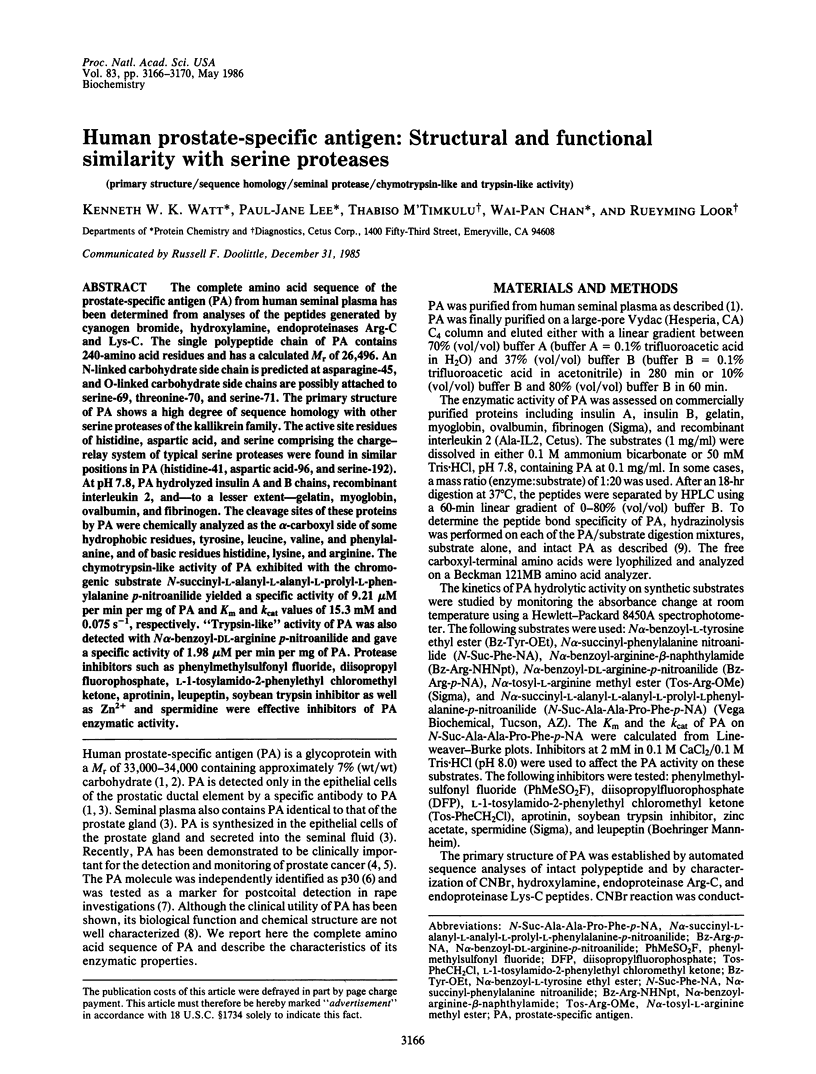
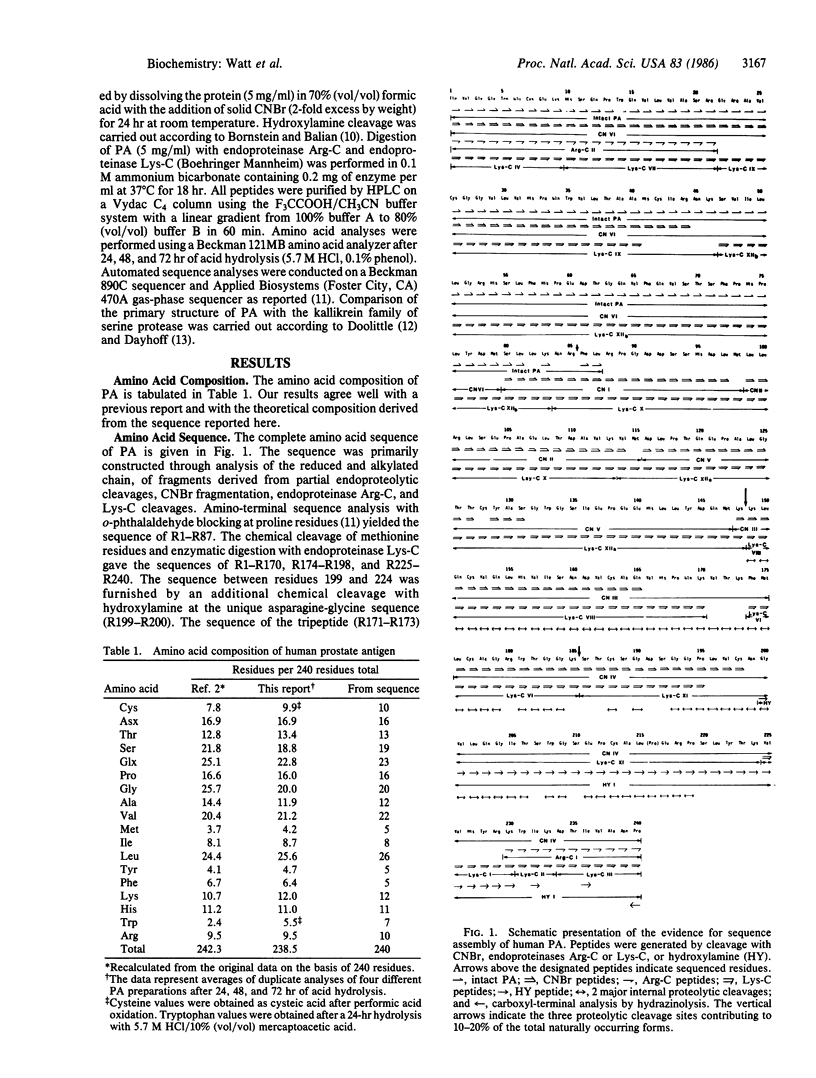
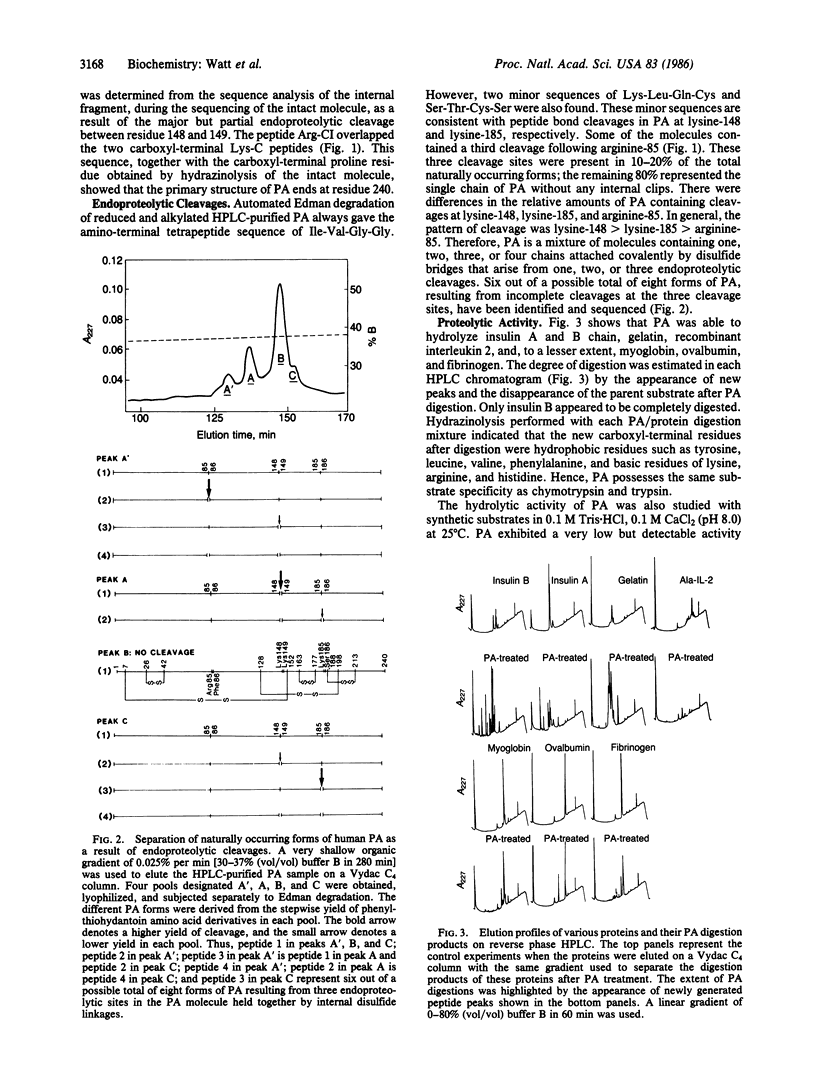
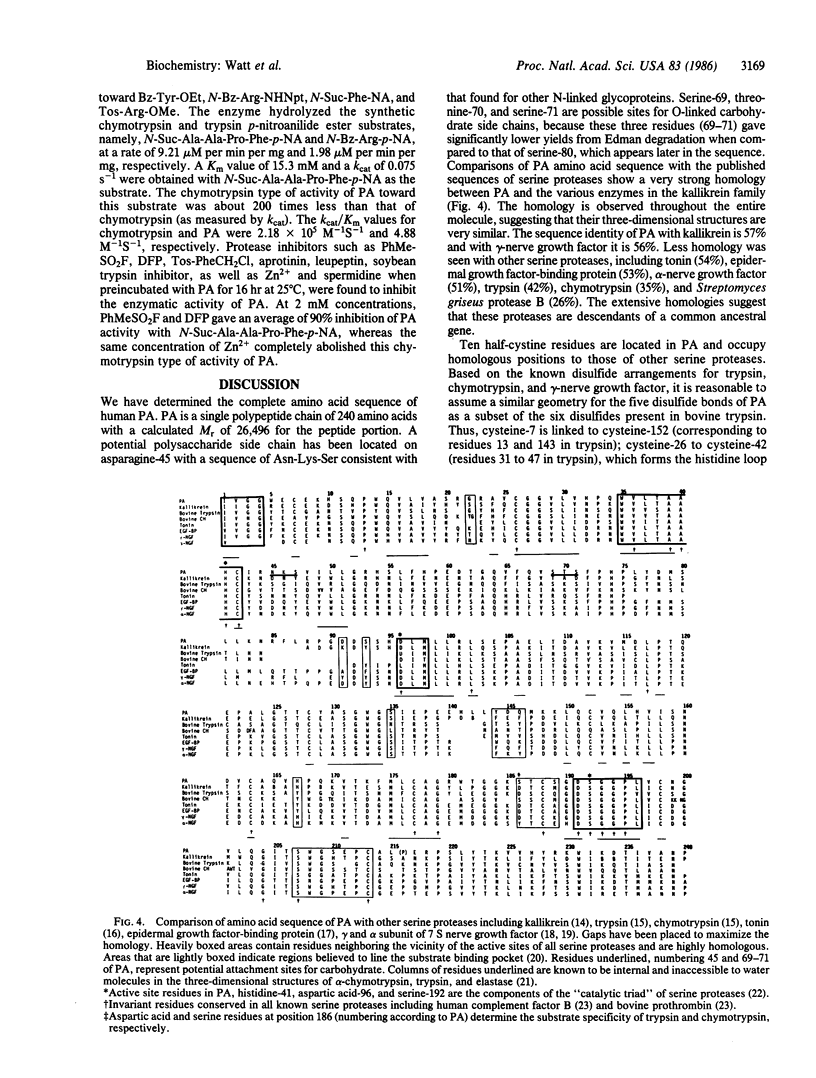
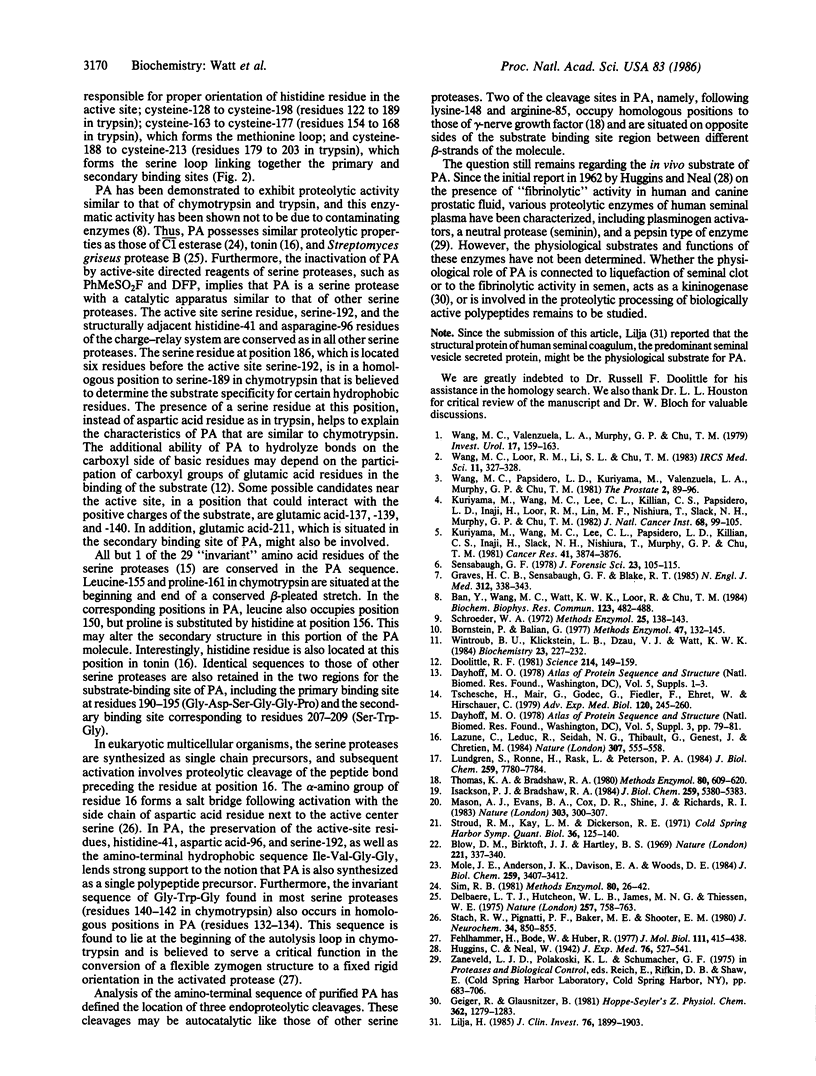
Selected References
These references are in PubMed. This may not be the complete list of references from this article.
- Ban Y., Wang M. C., Watt K. W., Loor R., Chu T. M. The proteolytic activity of human prostate-specific antigen. Biochem Biophys Res Commun. 1984 Sep 17;123(2):482–488. doi: 10.1016/0006-291x(84)90256-0. [DOI] [PubMed] [Google Scholar]
- Blow D. M., Birktoft J. J., Hartley B. S. Role of a buried acid group in the mechanism of action of chymotrypsin. Nature. 1969 Jan 25;221(5178):337–340. doi: 10.1038/221337a0. [DOI] [PubMed] [Google Scholar]
- Bornstein P., Balian G. Cleavage at Asn-Gly bonds with hydroxylamine. Methods Enzymol. 1977;47:132–145. doi: 10.1016/0076-6879(77)47016-2. [DOI] [PubMed] [Google Scholar]
- Delbaere L. T., Hutcheon W. L., James M. N., Thiessen W. E. Tertiary structural differences between microbial serine proteases and pancreatic serine enzymes. Nature. 1975 Oct 30;257(5529):758–763. doi: 10.1038/257758a0. [DOI] [PubMed] [Google Scholar]
- Doolittle R. F. Similar amino acid sequences: chance or common ancestry? Science. 1981 Oct 9;214(4517):149–159. doi: 10.1126/science.7280687. [DOI] [PubMed] [Google Scholar]
- Fehlhammer H., Bode W., Huber R. Crystal structure of bovine trypsinogen at 1-8 A resolution. II. Crystallographic refinement, refined crystal structure and comparison with bovine trypsin. J Mol Biol. 1977 Apr 25;111(4):415–438. doi: 10.1016/s0022-2836(77)80062-4. [DOI] [PubMed] [Google Scholar]
- Geiger R., Clausnitzer B. Isolation of an enzymatically active tissue kallikrein from human seminal plasma by immunoaffinity chromatography. Hoppe Seylers Z Physiol Chem. 1981 Sep;362(9):1279–1283. [PubMed] [Google Scholar]
- Graves H. C., Sensabaugh G. F., Blake E. T. Postcoital detection of a male-specific semen protein. Application to the investigation of rape. N Engl J Med. 1985 Feb 7;312(6):338–343. doi: 10.1056/NEJM198502073120603. [DOI] [PubMed] [Google Scholar]
- Isackson P. J., Bradshaw R. A. The alpha-subunit of mouse 7 S nerve growth factor is an inactive serine protease. J Biol Chem. 1984 May 10;259(9):5380–5383. [PubMed] [Google Scholar]
- Kuriyama M., Wang M. C., Lee C. I., Papsidero L. D., Killian C. S., Inaji H., Slack N. H., Nishiura T., Murphy G. P., Chu T. M. Use of human prostate-specific antigen in monitoring prostate cancer. Cancer Res. 1981 Oct;41(10):3874–3876. [PubMed] [Google Scholar]
- Kuriyama M., Wang M. C., Lee C. L., Killian C. S., Papsidero L. D., Inaji H., Loor R. M., Lin M. F., Nishiura T., Slack N. H. Multiple marker evaluation in human prostate cancer with the use of tissue-specific antigens. J Natl Cancer Inst. 1982 Jan;68(1):99–105. [PubMed] [Google Scholar]
- Lazure C., Leduc R., Seidah N. G., Thibault G., Genest J., Chrétien M. Amino acid sequence of rat submaxillary tonin reveals similarities to serine proteases. Nature. 1984 Feb 9;307(5951):555–558. doi: 10.1038/307555a0. [DOI] [PubMed] [Google Scholar]
- Lilja H. A kallikrein-like serine protease in prostatic fluid cleaves the predominant seminal vesicle protein. J Clin Invest. 1985 Nov;76(5):1899–1903. doi: 10.1172/JCI112185. [DOI] [PMC free article] [PubMed] [Google Scholar]
- Lundgren S., Ronne H., Rask L., Peterson P. A. Sequence of an epidermal growth factor-binding protein. J Biol Chem. 1984 Jun 25;259(12):7780–7784. [PubMed] [Google Scholar]
- Mason A. J., Evans B. A., Cox D. R., Shine J., Richards R. I. Structure of mouse kallikrein gene family suggests a role in specific processing of biologically active peptides. Nature. 1983 May 26;303(5915):300–307. doi: 10.1038/303300a0. [DOI] [PubMed] [Google Scholar]
- Mole J. E., Anderson J. K., Davison E. A., Woods D. E. Complete primary structure for the zymogen of human complement factor B. J Biol Chem. 1984 Mar 25;259(6):3407–3412. [PubMed] [Google Scholar]
- Sim R. B. The human complement system serine proteases C1r and C1s and their proenzymes. Methods Enzymol. 1981;80(Pt 100):26–42. doi: 10.1016/s0076-6879(81)80006-7. [DOI] [PubMed] [Google Scholar]
- Stach R. W., Pignatti P. F., Baker M. E., Shooter E. M. The characterization of the alpha-subunits of 7S nerve growth factor. J Neurochem. 1980 Apr;34(4):850–855. doi: 10.1111/j.1471-4159.1980.tb09657.x. [DOI] [PubMed] [Google Scholar]
- Stroud R. M., Kay L. M., Dickerson R. E. The crystal and molecular structure of DIP-inhibited bovine trypsin at2.7Angstrom resolution. Cold Spring Harb Symp Quant Biol. 1972;36:125–140. doi: 10.1101/sqb.1972.036.01.018. [DOI] [PubMed] [Google Scholar]
- Tschesche H., Mair G., Godec G. The primary structure of porcine glandular kallikreins. Adv Exp Med Biol. 1979;120A:245–260. doi: 10.1007/978-1-4757-0926-1_25. [DOI] [PubMed] [Google Scholar]
- Wang M. C., Papsidero L. D., Kuriyama M., Valenzuela L. A., Murphy G. P., Chu T. M. Prostate antigen: a new potential marker for prostatic cancer. Prostate. 1981;2(1):89–96. doi: 10.1002/pros.2990020109. [DOI] [PubMed] [Google Scholar]
- Wang M. C., Valenzuela L. A., Murphy G. P., Chu T. M. Purification of a human prostate specific antigen. Invest Urol. 1979 Sep;17(2):159–163. [PubMed] [Google Scholar]
- Wintroub B. U., Klickstein L. B., Dzau V. J., Watt K. W. Granulocyte-angiotensin system. Identification of angiotensinogen as the plasma protein substrate of leukocyte cathepsin G. Biochemistry. 1984 Jan 17;23(2):227–232. doi: 10.1021/bi00297a009. [DOI] [PubMed] [Google Scholar]


